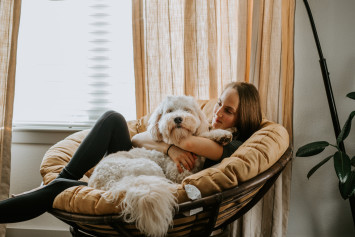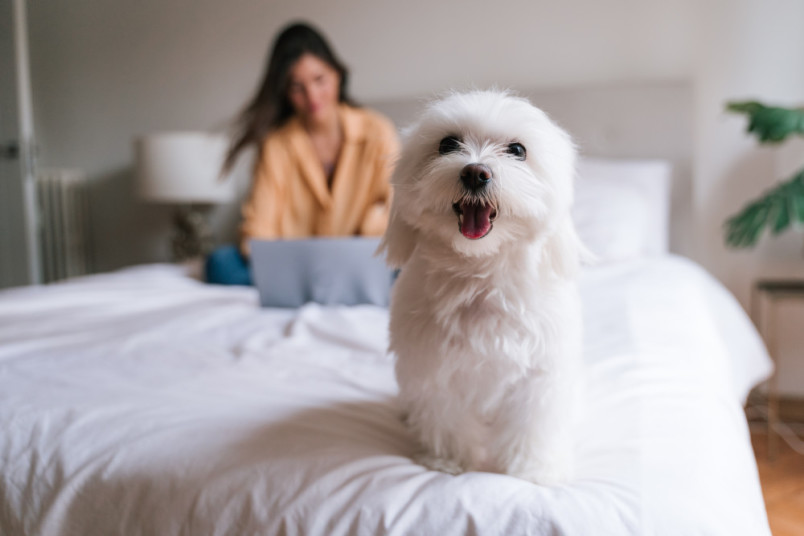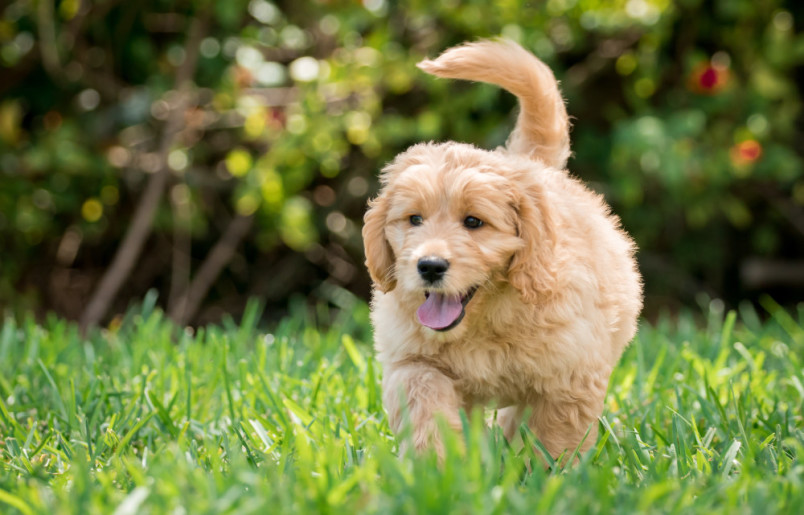
Have you dreamed of owning a dog, but your allergies have held you back? Good news! There are many hypoallergenic dog breeds that are perfect for allergy sufferers. Hypoallergenic dogs don’t shed as much hair and dander, so they can make the perfect companion for dog lovers with allergies. For those seeking a hypoallergenic option with an adorable appearance, some teddy bear dog breeds offer both low-shedding coats and charming, cuddly looks that many find irresistible.
What Causes Dog Allergies?
People who suffer from dog allergies react to a protein that is shed in dog dander, saliva, urine, and even blood. These proteins are spread easily and can circulate in the air or remain on the carpet or furniture for weeks and even months. As people move through a home with pet dander, those protein particles can even attach to clothing. People with dog allergies may begin coughing, sneezing, getting hives, and feeling generally uncomfortable.
What Are Common Hypoallergenic Dog Breeds?
Suffering from pet allergies can be a bummer, but the good news is that there are several hypoallergenic dog breeds to choose from! With so many different breeds, you’re sure to find one that isn’t just hypoallergenic but is also a good fit for your family and lifestyle.
While no dog breed is completely hypoallergenic, there are many breeds that produce less allergens, which makes them a great fit for someone who suffers from allergies. Some popular hypoallergenic breeds include Poodles, Maltese, and the Shih Tzu dog, which are known for their low-shedding coats and reduced dander production.
Poodle
You may have noticed that Poodles have become more popular in recent years, and that’s for good reason.
Poodles have vastly different fur from most dogs. In fact, Poodles have a single coat of hair that has a longer growth cycle than fur. Because of this long hair growth cycle, Poodles tend to not shed as much as most dogs. Since their hair is so dense and curly, any hair that does shed tends to remain in the coat. Poodles are a great option for allergy sufferers since they don’t shed very much.
In addition to their non-shedding coat, Poodles come in three varied sizes - toy, miniature, and standard. Poodles are highly intelligent, affectionate, and very people oriented. Overall, Poodles are great hypoallergenic dogs!
Maltese
The Maltese is a small, white dog with a long, straight, silky coat. Like Poodles, Maltese have a single coat of long hair that has a long growth cycle, so they shed less often. Since Maltese shed less often, that subsequently means that they’re releasing less dander into the air. This makes the Maltese a great breed for anyone who is looking for a small hypoallergenic dog.

Bichon Frise
Bichon Frise is another breed of small, white dog, but they have short, curly coats. They’re considered a great hypoallergenic dog breed since their short, curly coat releases less dander into the air. Aside from being a great hypoallergenic dog breed choice, they are resilient, confident, and have an all-around charming personality. This combination of small size with a wonderful personality makes them the best apartment dog for those with allergies in small spaces.
While the Bichon Frise may seem like the perfect little hypoallergenic dog, it’s important to investigate pet insurance plans to protect their health too! The Bichon Frise is prone to some health problems, like luxating patellas and cataracts. Opting for an affordable pet insurance plan after bringing home a new puppy will ensure that your pup is well taken care of before pre-existing conditions arise.
Portuguese Water Dog
The Portuguese Water Dog is a medium-sized dog with a thick, curly coat. They typically shed less often since they have a single, curly coat. In addition to their curly coat being a good option for allergy sufferers, they have a natural ability to swim, as their name suggests! They’re an intelligent, friendly, and patient dog breed, which makes them a great family pet.
Basenji
The Basenji is a medium-sized hunting breed that is incredibly athletic and highly intelligent. Basenjis are considered hypoallergenic and cause less problems for allergy sufferers because they have short hair that doesn’t shed often. In addition to being hypoallergenic, Basenjis are also relatively low-maintenance dogs. They do not require as much grooming as other breeds, and they are also relatively clean dogs. Basenjis are also known for being very intelligent and trainable. They make excellent companions for active people and families with children.
Afghan Hound
If you’ve ever seen an Afghan Hound, you’re sure to remember them! Afghan Hounds have a long, silky coat and a very regal presence. Like the other longhaired breeds mentioned here, the Afghan Hound has that long, silky hair with a longer growth cycle, so naturally, they shed less.
Hairless Hypoallergenic Dog Breeds
You may have noticed some commonalities in the list above that make those dog breeds good choices for anyone with allergies. Most of the breeds listed above either have short, curly coats or long, silky hair. Did you know that there are hairless dog breeds too?
Since hairless dogs are, well, hairless and don’t have hair, that means they don’t shed! Since there is no hair to shed, they spread much less dander than any other dog breeds. This makes them a great option for anyone who suffers from allergies.
Chinese Crested
One of the most popular hairless dogs is the Chinese Crested. Chinese Cresteds are almost entirely hairless. With so little hair on their body, they produce little dander and have very minimal shedding. They are small, lap dogs that love to cuddle!
American Hairless Terrier
Out of all the hypoallergenic dog breeds, American Hairless Terriers might be considered the most hypoallergenic! The American Hairless Terrier is entirely hairless, so there is no shedding. American Hairless Terriers are fun, energetic dogs, like other Terrier breeds.
Xoloitzcuintli (Mexican Hairless Dogs)
The Xoloitzcuintli (also known as Mexican Hairless Dogs or Xolos) is one of the oldest dog breeds in the Americas and have been around for at least 3,000 years. Like other beloved mexican dog breeds, the Xolo holds a special place in its country's cultural heritage as Mexico's national dog. While they are typically hairless, there is a coated variety. The hairless variety would be the best option for anyone who suffers from allergies since they don’t shed or produce as much dander.
What Are Some Other Hypoallergenic Dog Breeds?
While the breeds listed above are the breeds most frequently thought of when considering hypoallergenic dog breeds, there are some other breeds that may be suitable for people with less severe allergies.
Yorkshire Terrier
Don’t let the small size of a Yorkshire Terrier, also known as a Yorkie, fool you. Yorkies may be small, but they have energetic, fun, and feisty personalities. Yorkies pack a lot of punches into that little body, but they are fiercely devoted to their owners and make great pets. Since their single coat is long and silky and more like hair, they’re considered hypoallergenic since they shed so little.
Irish Water Spaniel
The Irish Water Spaniel is the tallest of all the Spaniels. They were bred to retrieve waterfowl and even have a flat tail that helps propel them as they’re swimming. They have a dense, curly coat that sheds very little.
Bedlington Terrier
The Bedlington Terrier is a small dog named after a mining town in England. While they were originally bred to hunt, their spirited, playful personality makes them a great family pet. With a distinctive appearance and a light-colored coat, Bedlington Terriers can almost look like sheep! They have a low-to-no shed coat and are considered a hypoallergenic dog breed.
Lhasa Apso
The Lhasa Apso originates from Tibet, China, and they were originally bred to be watchdogs. Unlike the other longhaired dogs in this list, Lhasa Apsos do have a double coat consisting of a softer undercoat and a long, coarse outer coat. Their long, coarse outer coat originally helped protect them against the harsh mountain climate they lived in. This coat type requires regular grooming. Even though they do shed their hair, they’re still considered to be a good option for allergy sufferers due to minimal hair shedding and overall cleanliness with regular grooming.
Coton de Tulear
The Coton de Tulear is a small, fluffy, friendly, affectionate dog. The Coton de Tulear has a long, fluffy, cotton-like coat. Since they have no undercoat and are considered to shed minimally, they are a great option for allergy sufferers.
Brussels Griffon
The Brussels Griffon is a small dog named after their city of origin in Brussels, Belgium. These are highly intelligent, yet highly sensitive, dogs that can be feisty and dedicated to their owner. Brussels Griffon can either have smooth or wiry coats. Dogs with wiry coats are the best option for allergy sufferers, since wiry coats don’t shed. Most Brussels Griffon also don’t tend to lick or drool much, so the minimal saliva helps reduce their allergy load.
Goldendoodle
Goldendoodles are a cross between a Golden Retriever and Poodle. Since they typically retain the thick, curly coat of the Poodle, they’re a great hypoallergenic dog breed. In fact, Goldendoodles are slowly rising in ranking and are becoming one of the most popular dog breeds in America. Aside from being hypoallergenic, Goldendoodles are intelligent, gentle, and loving dogs. They’re known for being energetic and active, so they make the perfect choice for an active family.

Best Tips for Allergy Sufferers
Suffering from dog allergies is no fun, so here are some tips that may make it possible for you to still be able to have a four-legged, furry companion by your side without causing you to constantly cough or sneeze.
Consider Choosing a Hypoallergenic Dog Breed
While we’ve discovered that there is no truly hypoallergenic dog breed, there are several dog breeds with differing characteristics, like minimal shedding or licking, that make them a better fit for someone who suffers from allergies. Dogs with either short and curly, or long and silky coats will tend to be the best, since these two coat varieties shed very little. Since saliva can also set off allergies, selecting a dog that doesn’t drool or lick much will also be beneficial.
Consider Choosing a Smaller Dog
In general, smaller dogs are less likely to bother your allergies. Since smaller dogs are smaller packaged, they have less of everything, including hair and saliva. With less hair and saliva being shaken off into the environment, your allergies are less likely to act up.
Test Your Reactions to Different Dog Breeds
If possible, test your allergies among different dog breeds and see what breed doesn’t cause them to flare up. Asking friends with hypoallergenic dog breeds if you can spend some time with their dog would be the ultimate test.
Create a Cleaning Routine
While most people aren’t huge fans of cleaning, a couple hours of deep cleaning every week is surely worth the reward of being able to keep a furry companion around without aggravating your allergies. Since allergies are a response to the protein found in hair, dander, and saliva, frequent cleaning of your home will keep those allergens at bay. Vacuuming and dusting a few times throughout the week, as well as wiping down surfaces, can decrease allergen levels.
Schedule Your Dog for Regular Grooming
No matter which dog breed you pick, having your dog regularly groomed will help keep your allergies at bay. Your dog will be clean with less dander and hair shedding inside your home.
Use an Air Purifier
High-efficiency particulate air (HEPA) purifiers running continuously can help reduce allergen levels over time. Similarly, regularly replacing air filters in your home’s HVAC system can also help lower the allergy burden.
There Might Just be a Hypoallergic Dog Breed for You!
It’s important to remember that allergies differ by person - what bothers one person’s allergies but not bother yours and vice versa. When possible, it’s best to test your allergies by spending time with different dog breeds to see if some may bother your allergies less than others.
While hypoallergenic dogs are better for your overall health and allergies, it’s important to consider your dog’s health anytime you bring home a new pup. Getting a pet insurance plan for your dog as soon as you bring him home helps you to be prepared for vet expenses. It gives you peace of mind and allows you to treat your dog quickly without worrying about the cost. After you pay your pet insurance deductible, your pet insurance plan will reimburse you for the expenses they cover. Plus, the sooner you get pet insurance, the less likely it will be that your pup will already have a pre-existing condition. This means any conditions that pop up with be covered, so you’ll get all the peace of mind of the world that your beloved dog will be well cared for—and that you can afford it!
Pet insurance is a great way to protect your furry friend from unexpected veterinary costs. But what if you could also get reimbursed for grooming costs? This is exactly what an optional add-on wellness program for pet insurance can do.
Grooming is important for all dogs, but it's especially important for pet owners with allergies. Grooming can help to reduce allergens by removing dander, dirt, and pollen from your dog's coat. This can help to alleviate allergy symptoms and make your home more comfortable for everyone.
An add-on wellness program for pet insurance can help you budget for the cost of grooming, so you can keep your dog healthy and allergy-free without breaking the bank. Most wellness programs cover a variety of preventive care services, including grooming.
Imagine a life where you can enjoy the companionship of a beloved dog without having to suffer from allergy symptoms. Hypoallergenic dogs make this dream a reality. With their low-shedding coats and reduced dander production, hypoallergenic dogs are the perfect choice for people with allergies.
And with pet insurance, you can rest assured that your furry friend will be taken care of, no matter what. Pet insurance can help cover the cost of unexpected veterinary expenses, so you can focus on enjoying your time together.
So what are you waiting for? Find your perfect hypoallergenic dog today and start living your best allergy-free life!